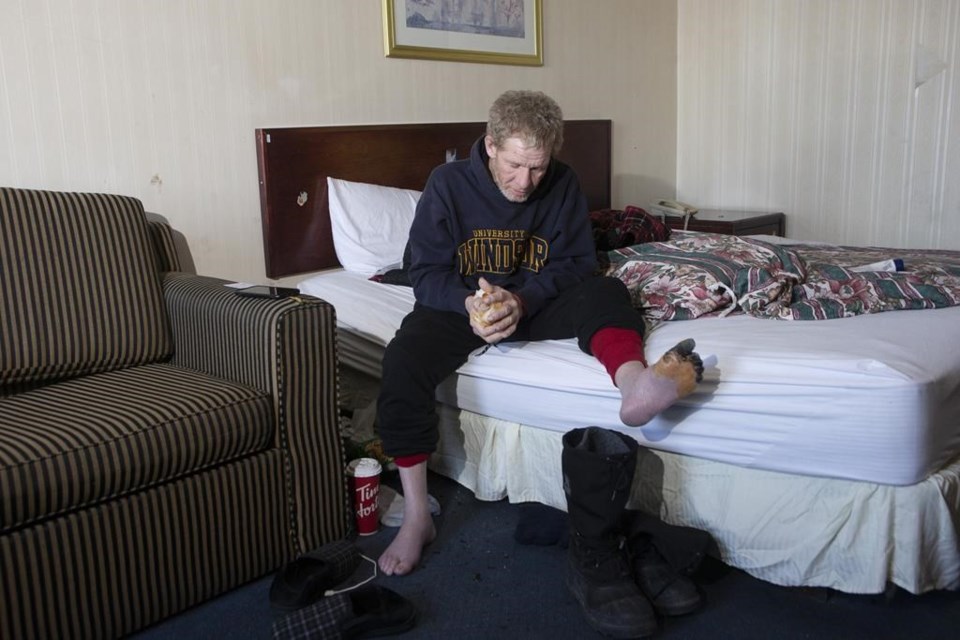TORONTO — The smell of rotting flesh fills the Toronto shelter room where Pat Gallagher lives in the city's north end.
He unwraps bandages that cover his left foot. His toes look like lumps of black coal. The diagnosis: severe frostbite.
"I pretend that it doesn't bother me, but when you look at your foot and you realize: 'I've seen that at the Royal Ontario Museum, that was on a dead mummy,'" he says.
"It starts to crawl up into your stomach and you get a little panic in and you feel a little sick."
Gallagher was set to have his toes and part of his foot amputated this week. The surgery was to be preceded by consultations with nurses, doctors and psychologists, followed by a lengthy rehabilitation to learn to walk again.
Health-care practitioners say this is the second difficult winter in a row for those who live outside. Pandemic pressures on an already-stretched shelter system as well as restrictions prohibiting eating – and getting warm – in fast-food restaurants have left many with nowhere to go on cold nights.
Gallagher's case is not unique, says Elizabeth Harrison, a nurse with Inner City Health Associates who treats the homeless.
She's seen a handful of cases of severe frostbite this year and last. Many have lost fingers and toes.
"These injuries are life changing," she says.
Warmth is one of the treatments.
"The most important thing for frostbite is to not get frostbite on it again," she says. "It's incredible the difference it makes if someone is able to get into one of these shelter hotels, or anywhere warm, compared to going back out on streets after getting frostbite."
Toronto's shelter system has been full or near capacity for years. This winter, Harrison and others say they have often called the city's central intake office only to be told no beds are available.
Emergency departments have become ad hoc warming centres, says Dr. Stephen Hwang, a physician and researcher at the MAP Centre for Urban Health Solutions at the Unity Health Toronto hospital network.
He says the network has an outreach worker who calls intake on cold nights in an effort to find spots inside shelters.
"There's just been not enough space for people," he says.
The city says it has added 400 new shelter spaces and 165 spots in warming centres this winter. It has also kept warming centres open since Jan. 7, instead of only during extreme cold weather alerts.
Advocates say that's not enough.
At least two homeless people have died as a direct result of the cold, although data on the subject is hard to come by.
Hwang says Bernard Kelly, a 74-year-old man with impaired cognition and multiple physical health problems, froze to death at a bus shelter in late January.
"I knew him, he was a good man, but he was very vulnerable and it's just tragic to see people like that freezing to death," Hwang says.
There were fewer than five homeless deaths at St. Michael's Hospital due to hypothermia between Nov. 1 and Jan. 31, a spokeswoman said, citing patient privacy as the reason an exact figure couldn't be given.
Toronto Public Health says three people who were homeless died from hypothermia between 2017 and the first half of 2021, although it notes there is no systematic data collection from police, hospitals or paramedics.
Hwang's research – published in 2019 in the International Journal of Environmental Research and Public Health – indicates that while frostbite and hypothermia are highest on extremely cold nights, dangers also exist on moderately cold nights.
His team found that 72 per cent of cases of hypothermia death or injury occurred when the minimum daily temperatures were warmer than -15 C.
"People may not realize that there's still a risk of dying or injury on those nights," he says.
It wasn't that cold the night Gallagher's feet froze.
Snow fell quickly on Jan. 17 when a blizzard hit southern Ontario, but the temperature hovered between -2 C and -3 C. Winds gusted upwards of 60 km/h.
He was out shovelling at a local grocer that pays him in food cards. He says he was warm and bundled properly. But he was sweating.
"I should have known better," he says.
Gallagher has spent the past 20 years on and off the streets. A bad car crash and a fall off a roof – he was a roofer – started him on opioids, which quickly became an addiction, he says.
He's become adept at staying warm and dry. He carries loads of dry socks and extra gloves. He layers up under snow pants and a heavy coat.
"But with COVID, everything was shut down and I couldn't actually go into a Tim Hortons or another place to use the washroom," Gallagher says.
"That stops any chance of changing socks, changing boots and drying stuff with the hand dryer."
That night he didn't want to return to his home – a box in the woods in the city's west end. It would be too cold.
So he went to an all-night laundromat to warm up.
"When I took my boots off, I found what looked like my feet, except there was this glass surface on it," he says. "And it was like looking at a foggy glass tube. It was bizarre. And I started to realize I'm in serious trouble here."
He called 911 and waited for the ambulance.
Weeks later, while awaiting surgery on his left foot, he hoped his right foot – still swollen, but a healthy pink – heals.
"It may seem like nothing to lose toes," he says, "but it's harder to walk on just a little stump."
This report by The Canadian Press was first published March 10, 2022.
Liam Casey, The Canadian Press

